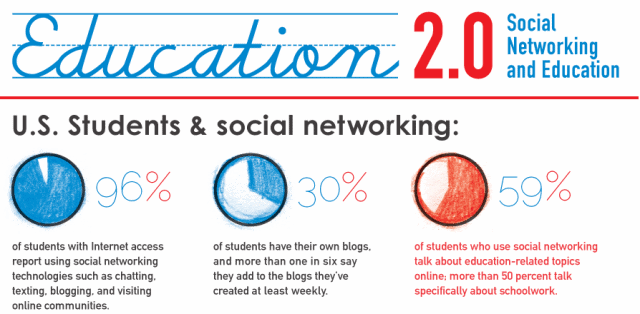Social media is not only changing the way we live our everyday lives, but also learning in and out of the classroom. With more students having access to smartphones at earlier ages now, teachers are also adjusting their teaching methods to incorporate social media for interactive and modern learning. With teachers and students both on social media platforms like Facebook, students are able to reach teachers easily after school hours to get help or simply to ask a question. Students are also able to stay up-to-date on the latest news without having to watch the news on TV. Things have definitely gotten a lot more convenient with social media, and students are taking advantage of the convenience it brings to their education. Let’s take a look at how social media has restructured education in the 21st century…

Source: Hilo Web Design
CONVENIENT COMMUNICATION
As mentioned briefly earlier, communication between student and teacher is a lot easier now. Before, students were restricted to e-mail or in-person discussions, but now, they can take place on Facebook, too. Parents can also reach their students’ professors easily in the event that they need to address an emergency or simply have a question about their child’s homework or upcoming exam. Students who may be too shy to speak up in class benefit greatly from social media because they are able to contact their teachers after school and have their questions addressed that way.
ALWAYS IN THE KNOW: CURRENT EVENTS
Students, parents, and teachers are able to stay up to date on the latest news related to education or anything happening in their areas. If there’s a shooting at a school, for example, everyone will instantly get quick access to this news on Facebook, Twitter, and Instagram, to name a few. Students can use their phones to quickly communicate with their parents to let them know that they need help or that they are okay. No longer do they need to rely on phone calls only, which can become inconvenient in certain circumstances.
GET EXTRA CREDIT
Many teachers nowadays are encouraging students to take advantage of social media to learn. As a result, they may offer extra credit for students who engage in a forum online after doing research. Students are likely to complete assignments like this if they are already spending a lot of their time on social media anyway. This is a great way to keep students learning, even during their leisure time.
EASY PEER COLLABORATION
Remember those days when you actually had to meet up with your peers to complete group projects? Those were the days… Not! Students nowadays don’t have to necessarily meet up with their classmates to finish groupwork if they don’t want to anymore. Resources like Google Docs, Facebook group chat, and Skype all allow students to interact with one another pretty easily. Google Docs is great because students are able to all work off of one document and be able to see their peers’ edits and additions in real time! If desired, students can even video chat and interact with each other face to face while working on their project. In this case, social media makes group very efficient, especially for busy students whose schedule never seems to match up with anyone else’s.
INCREASED ACTIVISM
Not everyone is registered to vote or has the privilege to do so, but more people than ever are able to easily voice their opinions on world matters, or even topics discussed in the classroom. Individuals can easily tag someone on Twitter with a message, or respond to an existing thread on Facebook to engage in discussion with others. Since so many people use social media (including those outside of school!), more and more people are able to see your opinion and thoughts once you post them to the public. Social media has certainly made it easier for people to contribute their insights and “make a difference.”
TECHNOLOGY FAMILIARITY
It has become widely known that repeated usage and exposure is the best way to become familiar with something. Nowadays, technology is used not only in school, but also in pretty much any job students end up taking on after graduation. The rise of social media has led students to be on their computers and phones a lot more than before. As a result, students are able to gain familiarity with their devices. An increased focus on technology in education will help students to develop skills needed for success in the working world.
A NEW CREATIVE SPACE
Social media has made it extremely easy for students to share their creative works. Whether it’s sharing photos that they’ve taken, paintings they’ve been working on, or an educational video in the works, students are able to upload it on their social media and get instant feedback from their followers, friends, and family. This helps students to refine their creative capabilities and encourages them to think outside the box. With the rise of entrepreneurship, having the creative outlets can be beneficial because it allows people to explore their talents and build confidence outside of regular school work.
EXPOSURE TO BASIC DESIGN ASPECTS
Social media is all about letting people customize their own networking profiles. By doing this, students are gaining exposure to basic design aspects and layout that are not taught in schools unless you’re studying graphic design. This exposure comes in handy when building resumes and personal websites in the working world. With the freelancer world becoming bigger, having attractive personal portfolios is a huge bonus! In fact, Instagram is a perfect example of this. Many bloggers, photographers, and models are using this channel to market themselves to potential clients, and showcase their work. In turn, clients are hiring creatives off of Instagram alone. Utilizing social media channels is a great way to get your work out there and become noticed for your talents.
LANGUAGE LEARNING
With video chat so readily available across multiple social media channels, it has become a lot easier for students to learn new languages. People can easily connect with others in the country of their language and practice with them, sort of like a “pen pal” but by voice via video chat. Practice makes perfect, and it’s become a lot easier for students to practice with natives of the language that they are learning and get constructive feedback on how to improve.

Source: Daily Infographic
Social media has its pros and cons, but the pros definitely stand out in the education world. Students, teachers, and parents are able to connect with each other much more easily, and using technology is no longer a huge struggle all across the board. Additionally, learning has become fun for students enrolled in classes where teachers choose to incorporate social media into their assignments and projects. With increased use of technology today, the use of social media is expected to help students learn quicker and complete assignments efficiently.
Another great thing about social media is that essentially, there is no age gap. Today, people of all ages from all around the world are connecting with one another through it. Teachers are finding new ways to make learning more creative and fun for students. Students are becoming familiar with technology and embracing their creative side while working hard in class. All in all, it’s a win-win for everybody so long as it’s not being misused!

"...in the big picture, people with associate degrees make more than people with high school diplomas. "
"Many students enroll in a 2-year college with the intention of transferring to a 4-year college and obtaining a bachelor’s degree."
"...the more degreed-education you have, the less likely you are to be unemployed."